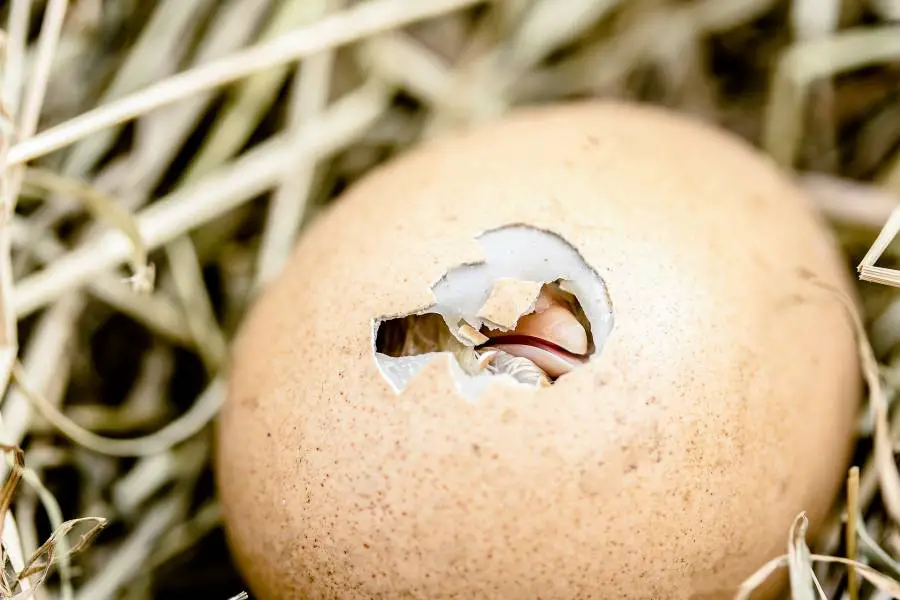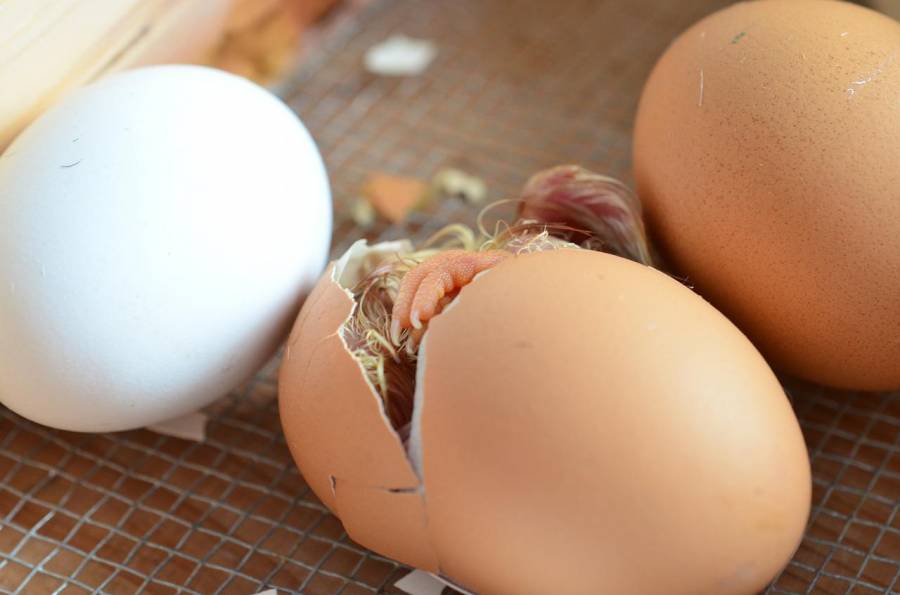Table of Contents
Hatching your chicks can be a wonderful experience, especially when the chicks are healthy and free of birth difficulties.
Though we all wish to have such an experience when hatching, complications may arise.
One such issue is when the yolk sac is separated from the chicks’ bodies after hatching.
Suppose you are experiencing this problem with your chicks or know someone with this challenge.

Then, this article will help you understand why your chick hatched with a yolk sac attached and what you should do.
Read on!
How Should A Chick Hatch?
When chicks hatch, they come out of the shell moist and cold, and that’s the ideal hatching state of a chick.
Observing that a chick hatched with a yolk sac attached implies that the chick did not absorb the yolk sac during its transformation process.
There is not much cause for alarm when you see situations like this. Because, if properly managed, the chick will be okay.
Why A Chick Hatched With Yolk Sac Attached?
There are three primary reasons a chick hatched with a yolk sac attached during formation, and they are highlighted below:
Hatching Too Early
Before chicks are hatched, they are expected to have absorbed the yolk sac before the incubation period between 16-21 days.
But, when the chick hatches before the time interval, it is prone to birth complications.
So, this is one of the reasons you see a chick hatched with a yolk sac attached.
The incubation period is the time it will take the egg to transform into a chick properly and before it is finally hatched.
Wrong Incubator Temperature
A wrong temperature of the incubator could affect the hatching time of the chick.
When the temperature is set too high, it will lead to the chick hatching earlier than expected.
The average temperature of an incubator is 37.5 degrees Celsius or 99.5 degrees Fahrenheit.
So, going above this temperature will cause the egg to hatch early; by 24 hours.
Assisted Hatching
A complication may also arise when you try to assist the egg in hatching. You will find the chick hatched with a yolk sac attached when this happens.
When you assist the chick early, the shell might still be moist, and it will alter the hatching process. So, avoid doing it too early when assisting your birds in hatching.
When A Chick Hatched With Yolk Sac Attached: What Should You Do?
Method 1: Allow The Yolk To Fall Off
When you notice this hatching problem, you can isolate the chick or chicks and allow them to absorb the yolk gradually.
The yolk will dry up and fall off the chick’s body if it does not absorb it. It usually takes a few hours for it to fall off the chick.
But, you should ensure that you are feeding the chick with food and water before and after the yolk falls off.
Neosporin is a triple antibiotic ointment that will dry the sac faster and protect the chick from developing an infection.
Also, to prevent the chick from being infected, you can apply some Neosporin to the yolk sac. You can also use other ointments such as Iodine instead of the Neosporin.
You should know that this might not work for all the infected chicks because it does not have a 100% certainty of success.
So, it would help if you had this in mind as you are trying out this method.

Method 2: Cutting Off The Yolk Sac
It is vital to isolate the affected chick or chicks because other birds might peck the yolk sac.
It might be very harmful to other birds and may lead to their death if not appropriately managed.
The isolated bird can infect itself with a hernia when it steps on the fallen yolk sac, which might lead to the chick’s death.
Also, when the yolk sac is allowed to fall off, it might pull out some of the chick’s innards as it slides out.
So, another option is to cut off the attached yolk sac from the chick. It may help protect the chick from future injury due to the yolk sac falling off.
How To Cut oOff The Yolk Sac
- Clamp the stump for 30 minutes, or you can choose to cauterize the stump immediately after you cut it off.
- Dip the chick’s bill in water containing sugar to keep it going after removing the sac.
Note
The method you will choose is dependent on the nature of the yolk sac. If the sac is absorbing into the chick’s body, you should not cut it off.
But, if the yolk sac is inconveniencing the chick and might pose a threat, you can cut it off. Be sure to follow the instruction on how to cut off the sac.
What Is The Function Of The Yolk Sac In Chicks?
Unlike mammals that nurture their young ones in their womb, chicks are nurtured inside eggs.
But, similar to young mammals, chicks are connected to an umbilical cord. This cord connects the chick’s body to the yolk sac, their nutrient source.
The yolk sac can sustain the chick for the first two to three days. After hatching, it has stored nutrients and calories that carry the chick for a few days.
Aside from the nutrients that the yolk sac provides chicks, it is also responsible for generating antibodies for the chick.
So, a chick that has not fully absorbed the yolk sac is at risk of poor growth and disease attacks.
How Long Does It Take For Chick To Absorb The Yolk?
The absorbing of the yolk sac is the last thing the chick does before it fully hatches. But, it can sometimes feel like an eternity when waiting for your first hatch.
Between the 18th and 19th day, the chick positions itself with its beak facing the air sac. The chick continues to absorb the yolk sac into its body.
While on the 2oth day, it pips, and it can take extra 24 hours before it fully hatches. So, the chicks take 24 hours to absorb the sac after pipping fully.
When Should I Assist The Chick To Hatch?
It is always tempting to want to help the chicks out of their shell, especially when it is your first time.
But, resist the temptation to carry out assisted hatching, except you are an expert.
After pipping, it might take another 24 hours before hatching. At that point, it feels good to help out by removing the cracked shell.
Helping the chick does more harm than good.
While the chick is still in the shell, it absorbs enough food and water to survive after hatching.
So, your help might interrupt that process and prevent the blood vessel from entering the chick.
The right time to help the chick is not always precise, but experience matters greatly.
You can observe the membrane; if it is dry, it could be a good sign that the yolk has been absorbed fully.
Conclusion
There is no problem without a solution, and why we are seeking to get the answer, we must endeavor not to create further problems.
Seeking understanding on how to deal with the issue of a chick hatched with a yolk sac attached is good.
But it would help if you strived to adhere to all the instructions and tips outlined in this article.






![Why Does My Bathroom Smell? [All Causes] Why Does My Bathroom Smell? [All Causes]](https://homesteadandprepper.com/wp-content/uploads/2021/05/Why-Does-My-Bathroom-Smell-150x150.jpg)

